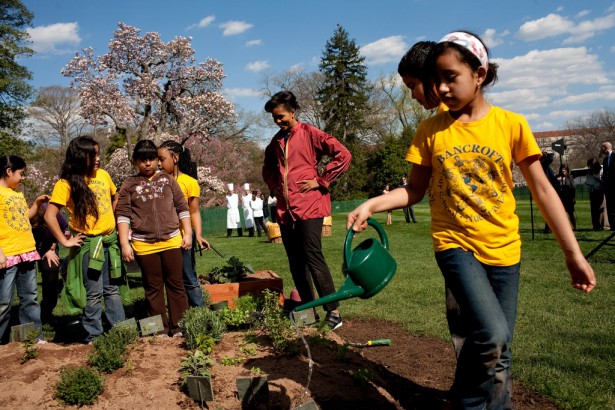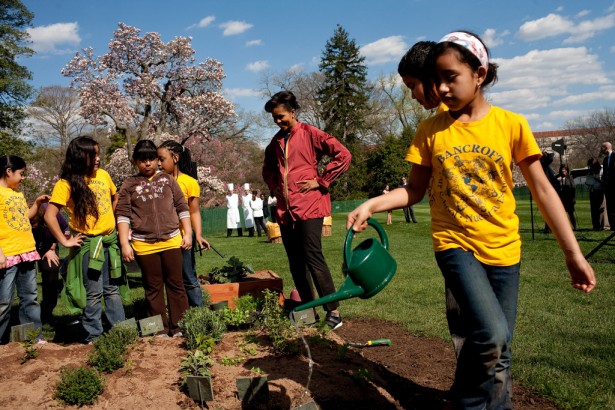 Michelle Obama working with local students in the White House garden.Photo: The Official White House PhotostreamPresident Obama said on Thursday that he and the First Lady are looking into setting up a farmers market just outside the White House, which might sell food from the White House garden or from local farmers. The president said it could give the city of Washington, D.C., “more access to good, fresh food, but it also is this enormous potential revenue-maker for local farmers in the area.”
Michelle Obama working with local students in the White House garden.Photo: The Official White House PhotostreamPresident Obama said on Thursday that he and the First Lady are looking into setting up a farmers market just outside the White House, which might sell food from the White House garden or from local farmers. The president said it could give the city of Washington, D.C., “more access to good, fresh food, but it also is this enormous potential revenue-maker for local farmers in the area.”
Obama mentioned the idea while answering a citizen question at a health-care forum; here’s the transcript:
Q. I have a two-part question. One is choice, the choice that we make to eat the foods that we eat and the lifestyle that we choose to engage in. And the second part, your family is very fit. What do you and the First Lady and the girls do to encourage physical fitness, and what can we — not the government, not private corporations — do to encourage activity in the public-school system and in young people?
A. PRESIDENT OBAMA: Well, this — this is a great question. Look, if — this is an interesting statistic. If we went back to the obesity rates that existed back in the 1980s, the Medicare system over several years could save as much as a trillion dollars. I mean, that’s — that’s how much our obesity rate has made a difference in terms of diabetes and heart failure and all sorts of preventable diseases.
And so what we want to do is to first of all, in health-care reform, in the legislation, encourage prevention and wellness programs by saying that any health-care plan out there has to provide for free checkups, prevention and wellness care. That’s got to be part of your deal, part of your package. And that way nobody’s got an excuse not to go in and get a checkup.
Now, even if we do all that — and there are a lot of — there are a lot of businesses out there that, on their own, are already providing incentives to their employees. Safeway, for example, is a company that has given financial incentives to employees to make sure that they are taking care of theirselves (sic) and getting regular checkups and mammograms and colonoscopies and so forth. And it has saved them a lot of money in terms of their premiums.
So there’s a — there’s a financial incentive for a lot of businesses to get in the business of prevention and wellness.
But you’re absolutely right that, even if we’ve got legislation, even if companies are encouraging it, part of what we also have to do, though, is teach our children, early, the importance of health. And that’s — that means that all of us have to, in our communities, in our places of worship, in our school systems, encourage nutrition programs, provide young people outdoor activities that give them exercise.
And Michelle and I always talk about the fact when — when we were kids, during the summer, you know, basically, mom just said, “See ya!” after breakfast. You were gone. (Laughter.) You might run in, get some lunch, go back out, and you wouldn’t be back till dinner. And that whole time, all you’re doing is moving.
Now, unfortunately, times have changed. Sometimes, safety concerns prevent kids from doing that. Sometimes, there are a lot of kids just don’t have a playground. Little leagues may be, you know, diminished. That means that, you know, we as adults in the community may have to provide more and more outlets for young people to get the kind of exercise that they need.
When it comes to food, one of the things that we are doing is working with school districts. And the child nutrition legislation is going to be coming up. We provide an awful lot of school lunches out there and — and reimburse local school districts for school-lunch programs. Let’s figure out how can we get some fresh fruits and vegetables in the mix. Because sometimes you go into schools and — you know what the menu is, you know? It’s French fries, Tater Tots, hot dogs, pizza and — now, that’s what kids — let’s face it, that’s what kids want to eat, anyway (Laughter.) So it’s not just the schools’ fault.
A, that’s what kids may want to eat. B, it turns out that that food’s a lot cheaper, because of the distributions that we’ve set up. And so what we’ve got to do is to change how we think about, for example, getting local farmers connected to school districts, because that would benefit the farmers, delivering fresh produce, but right now they just don’t have the distribution mechanisms set up.
So, you know, Michelle set up that garden in the White House?
One of the things that we’re trying to do now is to figure out, can we get a little farmers’ market — outside of the White House — I’m not going to have all of you all just tromping around inside — (laughter) — but right outside the White House — (laughter) — so that — so that we can — and — and — and that is a win-win situation.
It gives suddenly D.C. more access to good, fresh food, but it also is this enormous potential revenue-maker for local farmers in the area. And — and that — those kinds of connections can be made all throughout the country, and — and has to be part of how we think about health.



